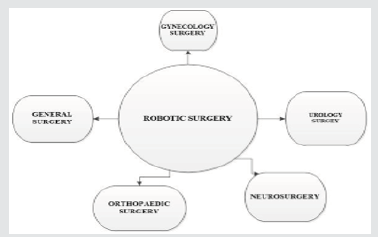Journal of Robotics & Mechanical Engineering | Lupine Publishers
 |
Smart Robotics for Smart Healthcare |
Abstract
Keywords: Intelligent Robotics, Smart robotics, Healthcare, Assistive Technologies
Introduction
Advances in Healthcare Robotics
Robotics in the present times has proliferated by leaps and bounds delivering successful, precise services and solutions in a number of domains [2]. Robotics with IoT has even transformed healthcare and opened numerous avenues. Some of its key focus areas include: surgical and interventional robotics, rehabilitative robotics, clinical workforce support, elderly and people with disability care, assistive living etc [1], [7–10]. Human Surgery has typically witnessed phenomenal changes with the introduction of robotic surgery [2]. Robots are being successfully applied for a number of surgical operations as depicted in Figure 1 below:Figure 1 above highlights the different avenues where robots have guided and performed minimally invasive surgeries [2]. Intuitive Surgical da Vinci robot has reportedly performed successful surgeries on almost 3 million patients worldwide [4]. They are being successfully used in neurosurgery to examine brain lesions without causing any major damage to the adjacent tissue. In orthopaedic surgeries robots shape the femur to fit prosthetic hip joint replacement with accuracy. With increased life expectancy due to better standards of living a growing demand has unfolded for assistive technologies, healthcare facilities and professionals to provide simple, affordable healthcare services to elderly people or people with disability in an unobtrusive manner. An IoT enabled solution to this demand has emerged in the form of smart homes equipped with wearable medical sensors, actuators and modern IT solutions [5]. ORCATECH Life Laboratory is one such in-house health monitoring solution [2]. Another requirement of trained health professional to provide look after and care to such patients has also been substituted by care bots to provide companionship or look after to patients [11].
Challenges in Healthcare Robotics Adoption
The advances in healthcare robotics are promising. However it is essential to still note some challenges in the domain and discuss how to overcome them. First and most importantly safety and reliability are critical to healthcare. There need to be efforts to ensure safe and gentle human-robot interactions. This especially needs to be taken care of when patients involved may be people with cognitive disabilities of kids. The next major challenge can be attributed to usability and acceptability of robots by clinicians as well as end users. This demands appropriate technical awareness and training. Only effective awareness, knowledge and training of all stakeholders involved in effective usage of healthcare robots can ensure successful usage of these robots. Another major limiting factor can be cost which includes their purchase, maintenance as well as training costs. Robot manufacturers should aim at devising techniques to manufacture and distribute well-trained and tested robots at the optimal possible costs.Conclusion
https://lupinepublishers.com/robotics-mechanical-engineering-journal/fulltext/smart-robotics-for-smart-healthcare.ID.000121.php
For
more Lupine Publishers Open Access Journals Please visit our website: https://lupinepublishers.us/
For more lupine publishers indexing Journals articles Please Click Here: www.lupinepublishers.com/robotics-mechanical-engineering-journal/index.php

No comments:
Post a Comment
Note: only a member of this blog may post a comment.